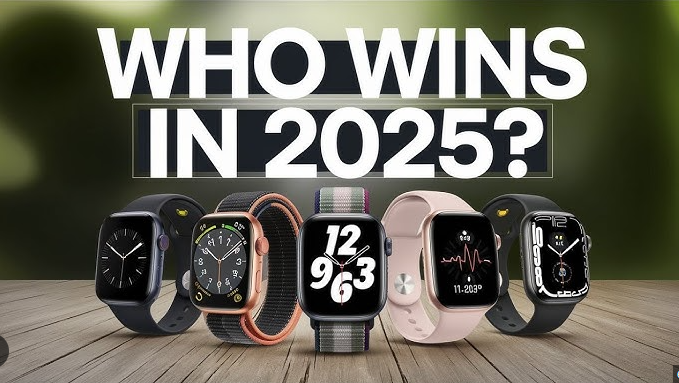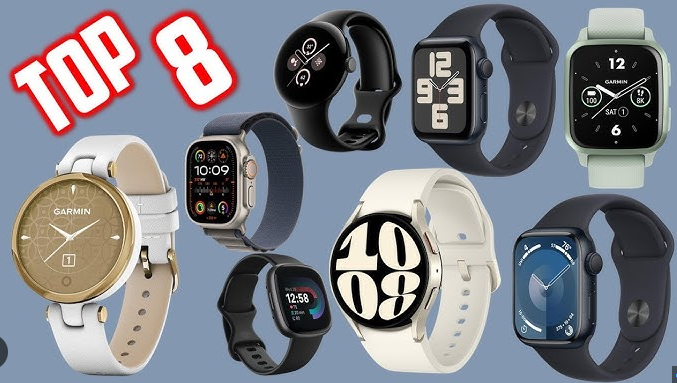In 2025, the Apple Watch remains the gold standard for iPhone users, and this Apple Watch review explores why it continues to dominate the smartwatch market. With its sleek design, advanced health features, and seamless iOS integration, the Apple Watch is more than a wearable—it’s a lifestyle companion. Whether you’re considering the flagship Series 10, the rugged Ultra 2, or the budget-friendly SE, this Apple Watch review dives into their performance, features, and usability. From smartwatch setup to smartwatch maintenance, we’ll cover everything you need to know to decide which model is right for you. Let’s explore why the Apple Watch is a top pick in this comprehensive best smartwatch guide.
Why the Apple Watch Stands Out in 2025
The Apple Watch is renowned for its polished design, robust app ecosystem, and cutting-edge health tracking, making it the best smartwatch for iPhone users. In 2025, the lineup includes the Apple Watch Series 10, Ultra 2, and SE (2nd Gen), each catering to different needs and budgets. This Apple Watch review evaluates their strengths, from fitness tracking to smartwatch safety features like crash detection, and offers practical tips for getting the most out of your device. With new features like sleep apnea detection and a reintroduced blood oxygen sensor, the Apple Watch continues to evolve, setting a high bar for competitors.
Apple Watch Models in 2025: A Breakdown
This Apple Watch review focuses on the three current models available, each tested extensively for performance, comfort, and functionality. Here’s how they stack up.
1. Apple Watch Series 10: Best Overall
Price: Starting at $399
Why Choose It: The Apple Watch Series 10 is the star of this Apple Watch review, earning a 4.5-star rating for its sleek design and advanced features. At 9.7mm thick, it’s the thinnest and lightest Apple Watch yet, with larger 42mm and 46mm case sizes and a wide-angle OLED display (up to 2,000 nits). The S10 chip powers fast performance, and new features like sleep apnea detection via the accelerometer make it a health powerhouse. The reintroduced blood oxygen sensor (available in the U.S. since August 2025 via watchOS 11.6.1) adds to its appeal, though data is accessed via the iPhone Health app in the U.S.
Key Features:
- Always-on Retina OLED display, 2,000 nits
- Health sensors: ECG, blood oxygen, heart rate, temperature, sleep apnea detection
- 50m water resistance, suitable for swimming
- 18-hour battery life; 80% charge in 30 minutes
- Double Tap gesture, on-device Siri, Tides app
Pros: Thinner design, larger display, and fast charging. The jet black aluminum finish adds a premium look at a lower cost. Swim tracking and GPS accuracy are top-notch.
Cons: 18-hour battery life requires daily charging. iPhone-only compatibility.
Best For: Most iPhone users seeking a balance of style, health tracking, and smart features.
Setup Tip: For smartwatch setup, pair via the Apple Watch app on your iPhone. Ensure iOS 18.6.1 and watchOS 11.6.1 for blood oxygen functionality.

2. Apple Watch Ultra 2: Best for Athletes and Adventurers
Price: Starting at $799
Why Choose It: The Apple Watch Ultra 2 is the rugged choice in this Apple Watch review, designed for athletes and outdoor enthusiasts. Its 49mm titanium case, 3,000-nit display, and 36-hour battery life make it ideal for extreme conditions. With 10ATM water resistance, it’s dive-ready (up to 40m), and dual-frequency GPS ensures precise tracking in challenging environments. The Action Button and emergency siren (86 decibels, audible up to 600 feet) enhance usability and smartwatch safety.
Key Features:
- 10ATM water resistance, EN13319 diving standard
- Dual-frequency GPS for superior accuracy
- 36-hour battery life; 72 hours in low-power mode
- Health sensors: ECG, blood oxygen, heart rate, temperature
- Action Button for customizable functions
Pros: Exceptional battery life, bright display, and durable design. Perfect for running, hiking, and diving.
Cons: Large 49mm size may not suit smaller wrists. High price.
Best For: Athletes, runners, and adventurers needing a portable smartwatch with advanced GPS and durability.
Troubleshooting Tip: For smartwatch troubleshooting, restart the watch if GPS or app performance lags, and ensure watchOS is updated.
3. Apple Watch SE (2nd Gen): Best Budget Option
Price: Starting at $249
Why Choose It: The Apple Watch SE (2nd Gen) is the budget-friendly pick in this Apple Watch review, offering core features at a lower price. With 40mm and 44mm case sizes, it uses the S8 chip for smooth performance but lacks advanced sensors like ECG and blood oxygen. Its 1,000-nit OLED display isn’t always-on, but it’s crisp and legible. The SE is swim-suitable (5ATM) and supports fitness tracking, making it a great entry-level option.
Key Features:
- 5ATM water resistance for swimming
- Heart rate, sleep tracking, and crash detection
- 18-hour battery life
- 40mm or 44mm aluminum case
- Apple Pay, Fitness Plus, and Family Setup support
Pros: Affordable, lightweight, and feature-packed for the price. Ideal for kids or first-time users.
Cons: No always-on display, ECG, or blood oxygen sensors. Older design with thicker bezels.
Best For: Budget-conscious users or those setting up a watch for kids via Family Setup.
Connection Tip: For how to connect smartwatch to phone, use the Apple Watch app and enable Bluetooth for a seamless setup.
Performance and Features: What Makes the Apple Watch Shine
This Apple Watch review highlights the standout features across all models, tested for real-world performance:
- Health Tracking: The Series 10 and Ultra 2 offer ECG, blood oxygen, sleep apnea detection, and temperature sensing. The SE covers basics like heart rate and sleep tracking. Blood oxygen data in the U.S. requires iPhone access via the Health app.
- Fitness Tracking: All models track workouts (running, swimming, yoga) with accurate metrics. The Ultra 2’s dual-frequency GPS excels for outdoor activities, while the Series 10 and SE are reliable for casual fitness.
- Smart Features: watchOS 11 (upgradable to watchOS 26 in September 2025) brings new apps like Translate and Tides, plus the Double Tap gesture for hands-free control. Siri, Apple Pay, and notifications work flawlessly with iPhones.
- Design and Comfort: The Series 10’s thinner profile fits under cuffs, while the Ultra 2’s 49mm case is bulkier but durable. The SE’s older design is still comfortable but less sleek.
- Battery Life: The Ultra 2 leads with 36 hours (72 in low-power mode), followed by the Series 10 and SE at 18 hours. Fast charging on the Series 10 hits 80% in 30 minutes.

How to Choose the Right Apple Watch
This Apple Watch review offers guidance on selecting the best model for your needs:
- Budget: The SE ($249) is ideal for cost-conscious buyers or kids. The Series 10 ($399) offers premium features at a mid-range price, while the Ultra 2 ($799) is for those needing rugged durability.
- Use Case: Choose the Ultra 2 for sports or outdoor adventures, the Series 10 for everyday use, and the SE for basic fitness and notifications.
- Size and Fit: Smaller wrists suit the SE (40mm/44mm) or Series 10 (42mm). Larger wrists can handle the Ultra 2’s 49mm case.
- Connectivity: GPS models suffice for most; LTE models (additional $100) offer phone-free connectivity but require a carrier plan.
Pro Tip: With the Series 11 and Ultra 3 expected in September 2025, consider waiting for potential new features like blood pressure monitoring or satellite connectivity, unless you find a good deal on current models.
How to Use an Apple Watch Effectively
Maximize your device with these how to use a smartwatch tips:
- Setup: Pair via the Apple Watch app on an iPhone running iOS 18 or later. Enable notifications, apps, and health features during smartwatch setup.
- Customization: Choose watch faces and widgets via the Watch app. Adjust notifications to avoid overload.
- Fitness Tracking: Use the Workout app for activities and close Activity Rings daily. Enable swim mode for pool sessions.
- Health Monitoring: Set up Medical ID and emergency contacts for smartwatch safety features like Fall Detection.
Troubleshooting Tip: If apps or sensors lag, restart the watch or update to the latest watchOS version to resolve smartwatch troubleshooting issues.
Apple Watch Maintenance and Cleaning
Keep your Apple Watch in top condition with these smartwatch maintenance tips:
- Cleaning: For smartwatch cleaning, wipe with a microfiber cloth. Rinse with fresh water after swimming, avoiding soaps or harsh chemicals.
- Strap Care: Clean silicone or nylon straps with water; use leather-specific cleaners for premium bands.
- Protection: Avoid extreme heat, cold, or prolonged water exposure beyond the rated 50m (Series 10, SE) or 100m (Ultra 2).
- Battery Health: Store in a cool, dry place and use Apple’s charger to maintain longevity.
Apple Watch Safety Tips
Ensure safe use with these smartwatch safety practices:
-
- Skin Health: Loosen the strap or switch to hypoallergenic bands (e.g., Sport Loop) if irritation occurs.
- Data Privacy: Secure health data with a passcode and review app permissions in the Health app.
- Emergency Features: Set up Emergency SOS and Check In for automatic alerts during accidents or travel.
Conclusion: Is the Apple Watch Worth It in 2025?
This Apple Watch review confirms that the Apple Watch remains the best smartwatch for iPhone users in 2025. The Series 10 offers a sleek, feature-packed experience for most users, while the Ultra 2 excels for athletes with its durability and long battery life. The SE (2nd Gen) is a budget-friendly gem for casual users or kids. With advanced health features, seamless iOS integration, and a polished design, the Apple Watch delivers unmatched value. Follow our smartwatch tips for setup, maintenance, and safety to maximize your experience. For more insights, visit maintenance tips at smartwatchus.com, your go-to best smartwatch guide.
Choose an Apple Watch today and elevate your fitness, productivity, and connectivity in 2025.